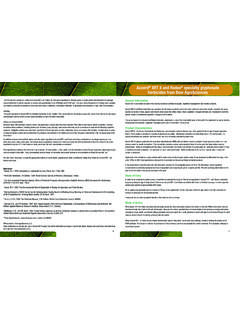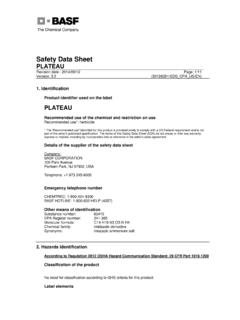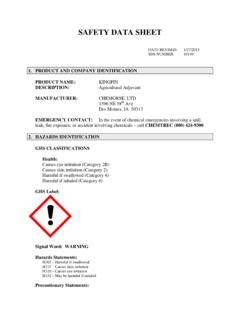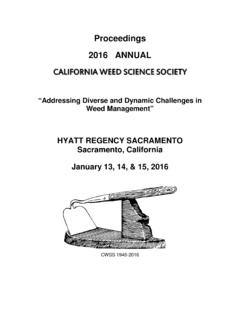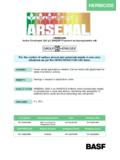Transcription of WHAT YOU SHOULD KNOW ABOUT TORDON …
1 WHAT YOU SHOULD know ABOUT TORDON herbicides . vegetation managers and foresters use Foresters control vegetation to maximize TORDON * herbicides to control unwanted weeds, the amount of timber they can harvest resulting brush and trees beneath electrical powerlines, in more timber harvested on less land. control - along railroad beds, roadsides, pipelines, in ling brush also decreases the potential for forest commercial forestry, and wildlife openings fires, and allows young stands to get started. including grazed areas on these sites. TORDON is Invasive plants, that affect all of the areas a trademark of Dow AgroSciences for herbi- we have talked ABOUT , threaten to create a cides containing picloram as the active ingredi- monoculture where one plant type dominates an ent.
2 Area. Invasive plants choke out native plant The following information provides species and wildlife habitats. Soon native specifics on TORDON , and explores questions grasses, flowers and other plant species, along commonly asked by people concerning its use. with native animals and birds, are driven out of the area. Why do you need to control vegetation in these Selective herbicides control these invasive plant species which promotes native plants that areas? in turn attract a wide range of wildlife. Nearly 50. years of research by Dr. William Bramble, a for- For most rights-of-way uses, safety re- est ecologist, and Dr.
3 William Brynes, an ecolo- mains a major reason for managing vegetation . gist specializing in forest soils, support the use Trees, brush and weeds along these rights-of- of selective herbicides to increase biodiversity. way can create hazards. (The Bramble and Brynes study was done in For driver and passenger safety, vegeta- conjunction with Penn State University, Purdue tion must not be allowed to block traffic signs or University and the Pennsylvania Game roadside markers. It must also not conceal Commission.). guardrails or overtake road shoulders. Vegeta- tion must not obstruct driver vision at intersec- tions or block the line of sight around curves.
4 Why do you need to use TORDON ? Can't you Excessive vegetation also prevents proper drainage, which can damage roadbeds by cre- just cut the vegetation ? ating potholes and other hazards. Mowing and trimming remain important Trees growing into powerlines can cause parts of any vegetation maintenance program. electrical power outages and make mainte- But mechanical means alone cannot protect nance difficult and dangerous. In addition, these areas adequately. Besides being very areas around utility substations and land labor intensive, mechanical methods cause soil beneath transmission towers require a vegeta- compaction that can lead to soil erosion.
5 And tion-free zone to prevent fire hazards and flailing blades and moving parts pose a danger ensure the transfer of electricity. to employees, livestock and wildlife. Flying Railroad companies need to control debris from mowers can potentially damage weeds along their rights-of-way to maintain your property. roadbeds. Weeds hold water around railroad Mowing creates multiple resprouts the ties. This causes them to rot, increasing plant's natural defense to the cutting. This only chances for derailment accidents. Sparks from worsens the vegetation problem.
6 The rails can also ignite weeds and brush grow- In some cases, mechanical methods quite ing too close to the roadbed, which can create a simply cannot be used. Steep terrain may limit fire hazard for neighboring residents. Brush that access by mowers, and in the case of railroads obstructs motorists' views at railroad crossings and substations, their crushed-stone construc- is especially dangerous. Controlling it can help tion makes mechanical weed control impossible. avert car/train accidents. TORDON controls unwanted brush and elim- application rate and technique for that location.
7 Inates resprouting. Because of this improved The manager considers many factors, such as control , crews and heavy machinery visit the season, temperature, weather and terrain. area less frequently, meaning less impact on property near yours. How do these applicators know they are Who will be applying TORDON ? applying the correct amount of TORDON ? A vegetation manager plans TORDON The label indicates the rates to be used. herbicide treatments and oversees crew Before an application begins, crews test the activities. Trained, professional applicators application equipment and calibrate all spray apply TORDON in designated areas using nozzles to ensure they meet these label direc- approved application techniques.
8 Organizations tions. may use on-staff crews or hire custom applica- tors. In either case, these applicators follow directions on the product label, which is Will TORDON harm my ornamentals or garden? reviewed by the Environmental Protection TORDON has the potential to harm any Agency. woody or broadleaf plant that comes in direct Aerial applicators are highly trained and contact with the spray solution. Therefore, appli- use specialized equipment to make applications cators take care to apply TORDON only on tar- geted vegetation specified by the vegetation How do I know these applicators are trained manager.
9 Crews use extra caution to protect your properly? ornamentals or garden, leaving untreated buffer zones that add an extra measure of pro- It's in the best interest of any organization tection. When making foliar applications, crews to hire qualified people to handle applications carefully monitor wind speed and direction to for the good of the organization itself and its assure accuracy. Drift- control agents can also standing in the community. be mixed with the spray solution to produce Only state-certified applicators or those larger, heavier droplets that aid application under their direct supervision may apply TORDON .
10 Accuracy and reduce chances for off-target drift. TORDON herbicides are classified as restricted- use pesticides because of their ability to injure susceptible plants at extremely low rates. The Is TORDON considered toxic? rigorous training required for state certification Picloram, the active ingredient in TORDON , helps ensure that applicators apply TORDON has been classified as Category E evidence properly, limiting the potential for damage to of non-carcinogenicity to humans by the EPA. nontarget vegetation . (the most favorable classification possible), and In addition, an experienced crew foreman has been found to be practically nontoxic to oversees the application process to mammals, birds, and honeybees.
